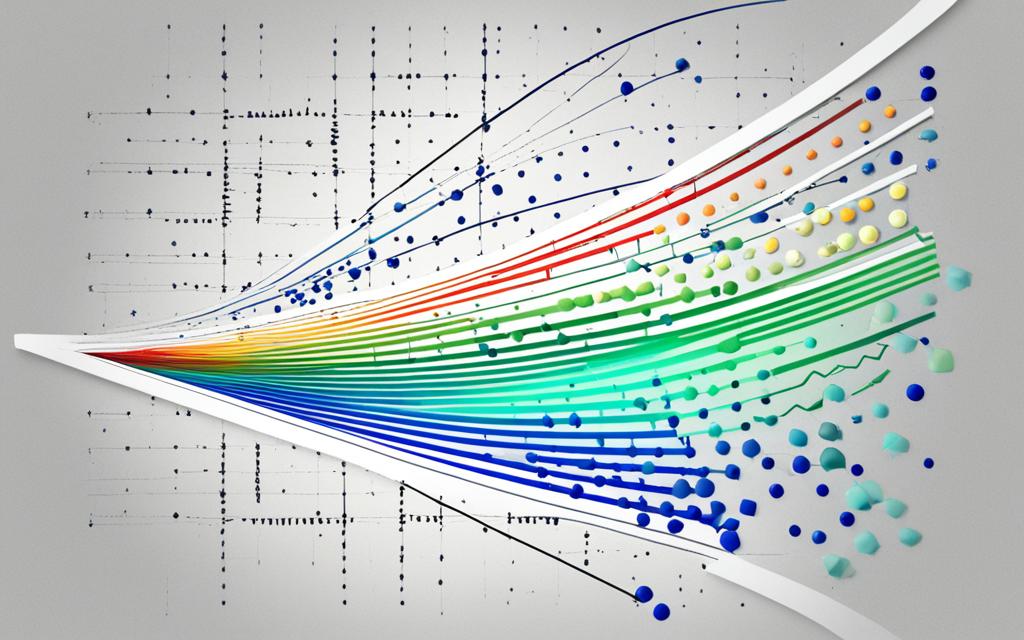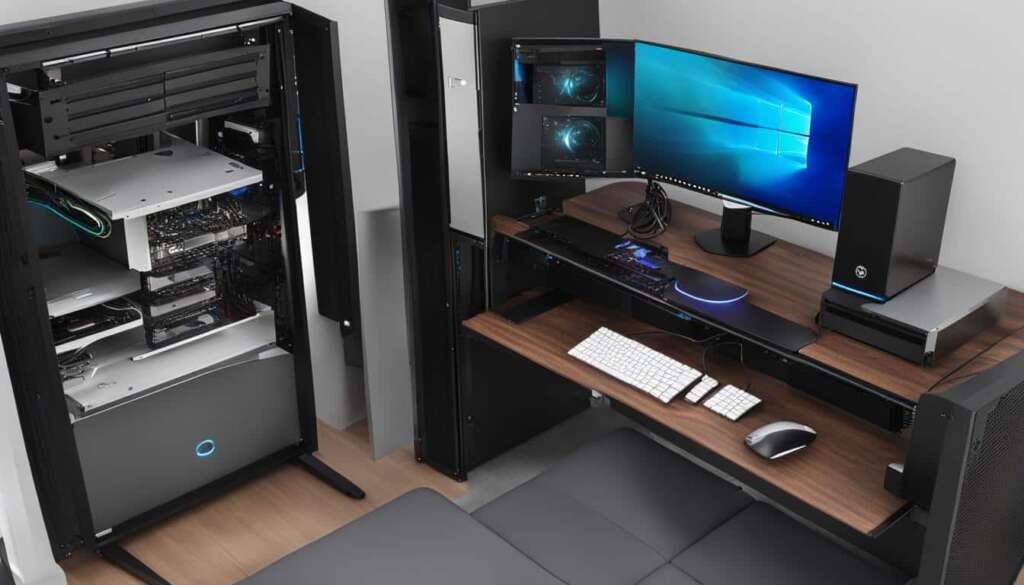Table of Contents
The IS-MP-PC model is a vital tool in macroeconomics. It examines how interest rates, inflation, and output change over time. Experts use this model to understand economic interactions and outcomes. It came from the mind of Bilgin Bari, showing how demand, monetary policy, and other factors shape the economy’s short-term path.
This model breaks down into three parts: aggregate demand, monetary policy, and the Phillips Curve. Aggregate demand totals up spending on goods and services. It’s shaped by how consumers, governments, and businesses spend their money. Monetary policy involves central banks managing the supply of money, interest rates, and inflation levels. The Phillips Curve shows how unemployment links to inflation rates.
To grasp the IS-MP-PC model, we must explore these parts’ connections. It tells us how interest rate adjustments and output shifts touch on demand and inflation. Also, it looks at how changes by central banks in the supply of money or interest rates affect demand, output, and inflation. This knowledge helps those setting policies and economists to navigate through economic variabilities and stabilize the economy.
Through Bilgin Bari’s IS-MP-PC model, we get to dive deep into the ways interest rates, output, inflation, and other economic elements interact. It’s key for understanding how short-term economic activities operate. Plus, it lays the groundwork for broader insights into inflation and interest rate trends.
Key Takeaways
- The IS-MP-PC model is a macroeconomic tool that analyzes short-run fluctuations in interest website, inflation, and output.
- It consists of three main components: aggregate demand, monetary policy, and the Phillips Curve.
- The model helps explain the relationships between these components and how they impact the economy.
- Bilgin Bari’s IS-MP-PC model provides valuable insights into short-run economic dynamics and forms the basis for understanding broader movements in inflation and interest rates.
Formation of the IS/MP Model
In the economic world, the IS/MP model comes from two important curves interacting: the MP and the IS curve1. The MP curve shows how the real interest rate and inflation rate connect, growing as they go up. Central banks, like the Federal Reserve, change the MP curve by altering the federal funds rate and doing open-market operations1.
The IS curve, however, shows a drop in total output when the real interest rate goes up1. Government spending and how consumers act shape this curve’s movements. When consumer or government spending increases, the IS curve moves right, raising total output at the same interest rate1.
These curves, the MP and the IS, are key for grasping the IS/MP model’s workings. They help us see how interest rates, inflation, and total output interlink, aiding in making policies to steer the economy right.
Analysis of the IS/MP Model
The IS/MP model helps us see how the economy behaves under different situations. It shows us how changes in monetary policy affect things like interest rates, total output, and the cost of living. By looking at the IS and MP curves, we understand how these elements work together.
When the central bank lowers interest rates, the MP curve moves to the right. This move makes borrowing cheaper, which leads to more spending and investment. As a result, the economy grows as shown by the IS curve moving downwards2.
This model isn’t just for studying short-term economic changes. It also fits into bigger models that look at long-term trends like inflation and interest rates over time.
Studying the IS/MP model tells us what affects the economy’s growth and inflation. Decisions made by policymakers, based on this model, are vital. They steer the economy by controlling the supply of money and setting the real interest rates2.
The IS curve shows that higher interest rates can reduce investment and slow down the economy. Meanwhile, the MP curve connects the dots between output and the interest rate. Goals set by policymakers affect how much goods and services are produced, job levels, and the inflation rate.
For a deeper understanding, comparing Keynesian and neoclassical theories is helpful. Including a labor market part in the IS/MP model gives a fuller picture. It helps predict not just output and interest rates but also employment levels and wages. The model also checks if prices match up with these predictions3.
Keynesian and neoclassical solutions:
- Keynesian thinking underlines the need for government action to keep the economy stable. It divides economists into two groups based on their views on handling the economy3.
- Neoclassical theory is more cautious. It questions if the economy can balance itself without help. This view focuses on inflation and the differences in production levels to find the right interest rate3.
- The IS/MP model’s strength lies in its combined approach. It uses real interest rates to mirror actual monetary policies, like those by the Federal Reserve in the US2.
- Different factors, such as how much money is in circulation and price changes, are crucial. They help fully understand how the economy works in various situations3.
In conclusion, the IS/MP model sheds light on economic dynamics and the role of monetary policy. By exploring the links between the MP and IS curves, we can foresee the outcome of interest rate adjustments on the economy’s essential aspects.
Criticism of the IS/MP Model
The IS/MP model is widely used and gives valuable insights. Yet, it’s been critiqued by economists like Greg Mankiw. They suggest other models like IS/LM for exploring money supply, interest rates, and economic activity ties. Mankiw believes the IS/MP model overlooks some vital connections. This oversight leads to odd traits in the model4.
Despite the critique, the IS/MP model is still popular for teaching macroeconomics. It’s praised for its simplicity and quick decision-making help. But it has downsides and makes some unrealistic assumptions about the economy. Still, its usefulness in education is clear4.
Critics also point out the model’s outdated view on central banks focusing on money supply. Nowadays, central banks target inflation instead. This change has made the IS/MP model less relevant in modern economic studies5.
Moreover, the IS/MP model concentrates on interest rates as the central goal of monetary policy. But since the 1980s, the strategy has changed. Policies now aim to directly influence interest rates rather than control the money supply5. This change shows how monetary policy tools have evolved over time.
Recently, the European Central Bank’s Transmission Protection Instrument (TPI) has shed light on the IS/MP model’s limits. The TPI buys government debt to manage sovereign spreads in the euro area. It activates only under certain conditions to tackle market issues that affect monetary policy6. This highlights a need for models that can handle dynamic policy impacts on financial markets.
In spite of criticisms and new models like the IS/LM or IS-MP-PC by David Romer, the IS/MP model remains important in teaching. It helps students understand how monetary and fiscal policies interact. These interactions affect interest rates, output, and the economic stability56.
Aggregate Demand and the IS/MP Model
The IS/MP model is important for understanding how aggregate demand works in an economy. It includes ideas from other models, like IS/LM and IS/MP. These ideas help us see how overall demand for goods and services changes7. Aggregate demand is the total demand for goods and services at a specific price level7. It’s affected by consumer and government spending, investments, and the difference between exports and imports.
This model shows how different factors interact and affect demand. It looks at how changing interest rates, inflation, and government financial actions can impact aggregate demand7. Through this model, those who make policies and economists can better predict how changes will influence economic activity.
Part of the IS/MP model is the Mundell-Fleming model. It suits economies that are open and have free movement of money across borders7. This part explains how monetary policy can change exchange rates, capital movements, and exports7. It shows that alterations in money supply and interest rates can affect these aspects, influencing overall demand.
The model also uses the Phillips curve. This curve shows a link between wage inflation and joblessness3. It suggests that, over time, the relationship between inflation and unemployment changes, impacting short-term inflation3. By adding the Phillips curve, the IS/MP model aids in understanding how demand, inflation, and unemployment are connected.
Moreover, the IS/MP model compares Keynesian and classical approaches by integrating additional aspects3. This comparison helps economists test different policies and find out what affects demand in varying economic situations.
Different graphs and models are used to explain the IS/MP model. These visuals show how changes in interest rates and output levels can create a balance, giving a clear picture of how demand and the economy interact3.
In summary, the IS/MP model is a useful tool for analysing demand dynamics. With its mix of theories and real-world examples, it provides valuable insights. Thus, it helps those in economics and policy-making understand key factors that shape aggregate demand and economic performance.
Monetary Policy and the IS/MP Model
The IS/MP model shows us how monetary policy shapes our economy. Central banks, like the Federal Reserve in the US, use tools to control the economic situation. This helps them meet their goals. Knowing how monetary policy affects the economy is key for those making decisions and investing.
The MP curve in the IS/MP model shows how the central bank’s interest rates work with inflation. By changing interest rates, they affect loans, investments, and shopping habits. This, in return, changes the overall demand and the economy’s performance. So, monetary policy is vital for economic progress.
This model mixes different factors to examine monetary policy’s influence. It includes variables within the system and those from outside, along with expectations and several parameters. Through these aspects, it gives a deep dive into how different influences mold the economy.
Using data on the IS/MP model highlights why understanding monetary policy matters. Lectures delve into topics like the best inflation rate and targeting inflation (source)8. They cover Monetary Policy Rules and the broad IS-MP-PC Model, touching on economic theories like Rational Expectations8. Recommended readings add more insight into monetary policy and maintaining a stable economy with authors like Karl Whelan and Carl Walsh8.
Grasping the IS/MP model aids in linking monetary policy with key economic figures like inflation. Using equations and analyzing these connections help in understanding economic impacts8. This enables policymakers to see how outside factors and policy changes affect the economy8.
The central bank uses this model to optimize its moves by weighing the outcomes of inflation against economic performance9. Minimizing losses through this balance aids in making beneficial economic decisions. The model also shows why timing is crucial in monetary policy effects9.
Forecasting is crucial for central bank decisions within the IS/MP model. Predicting economic trends helps in preparing for future policy effects9. This lets the central bank set the right interest rates for their goals9.
The IS/MP model provides a thorough analysis of monetary policy and its economic impact. Understanding how policies shape economic dynamics guides policymakers. The inclusion of various data and elements makes the model both realistic and useful89, proving essential for monetary policy discussions and decisions.
Conclusion
The IS/MP model, even though it’s critiqued, is still important for looking at how money and government plans affect the economy. It helps people understand the economy better and make smart choices about money and government spending. This model is also a starting point for more complex studies. It shows how interest rates, inflation, and government spending can change demand and the economy’s performance7.
The 3-equation New Keynesian model also gives deeper insights into the economy. It includes the IS curve, Phillips curve, and a rule for monetary policy based on interest rates (IS-PC-MR). It talks about the output gap, controlling interest rates, and how inflation strays from its target. These ideas help central banks decide on monetary policy. Charts and diagrams make it easier to grasp these concepts in the model9.
Together, the IS/MP model and the 3-equation New Keynesian model help us get the economy. They guide policymakers in making vital decisions for economic health. By using these models, analyzing data, and looking at different factors, leaders can aim for a stable and growing economy. As things in the world change, these models stay key in understanding and handling the economy’s ups and downs79.
FAQ
What is the IS/MP model?
The IS/MP model, also known as the Investment-Savings/Monetary-Policy model, shows how interest rate, inflation, and output change in the short-run.
What are the main curves in the IS/MP model?
In the IS/MP model, there are two key curves. The MP curve links the real interest rate with the inflation rate. The IS curve connects the real interest rate with total output.
What causes shifts in the MP and IS curves?
Changes in the MP curve come from the Federal Reserve’s actions, like adjusting the federal funds rate. The IS curve shifts due to government spending and how consumers act.
How does the IS/MP model analyze economic scenarios?
The model analyzes different economic situations. For instance, cutting the federal funds target rate moves the MP curve right. This reduces the real interest rate and raises inflation.
Such a lower interest rate boosts total output, indicated by a move down along the IS curve.
What criticisms has the IS/MP model faced?
Critics like Greg Mankiw prefer the IS/LM model over the IS/MP model. They argue the IS/MP model misses some key aspects, giving it odd traits.
The IS/MP model links closely with aggregate demand, the total demanded output in the economy. It shows how interest rates, inflation, and fiscal policy changes affect aggregate demand and output.
What is the role of monetary policy in the IS/MP model?
This model is key to understanding monetary policy’s economic role. Central banks’ policies are depicted by the MP curve, showcasing the link between the central bank’s real interest rate and inflation.
Why is the IS/MP model valuable for analyzing monetary and fiscal policy?
It’s a powerful tool to study how monetary and fiscal policy interact with the economy. It explains the effects of interest rates, inflation, and government spending on aggregate demand and output.
Source Links
- https://web.econ.ku.dk/okocg/VM/VM16/Lectures and lecture notes/Special-Note4-VM2016.pdf – PDF
- https://eml.berkeley.edu/~dromer/papers/ISMP Text Graphs 2013.pdf – Microsoft Word – ISMP Text Graphs 2013 3
- https://www.boeckler.de/pdf/v_2012_10_25_betz.pdf – PDF
- https://www.investopedia.com/terms/i/islmmodel.asp – IS-LM Model: What It Is, IS and LM Curves, Characteristics, Limitations
- https://en.wikipedia.org/wiki/IS–LM_model – IS–LM model
- https://www.intereconomics.eu/contents/year/2023/number/5/article/the-activation-conditions-of-the-transmission-protection-instrument-flawed-by-design.html – The Activation Conditions of the Transmission Protection Instrument: Flawed by Design?
- https://www.reed.edu/economics/parker/EUBA/Doctoral/notes/Week5.pdf – Microsoft Word – EUBA Doctoral Lecture Notes.docx
- https://wuecampus.uni-wuerzburg.de/moodle/pluginfile.php/3134492/mod_resource/content/1/Slides7_SolvingISMPPC.pdf – PowerPoint-Präsentation
- https://www.ucl.ac.uk/~uctpa36/3equation_book_chapter.pdf – new3!model1.dvi








